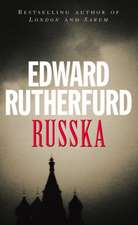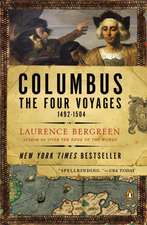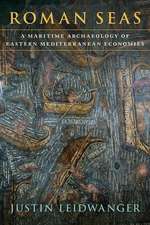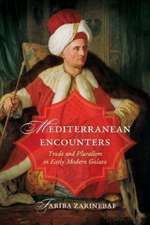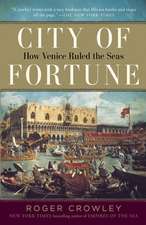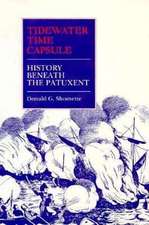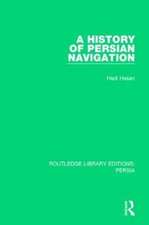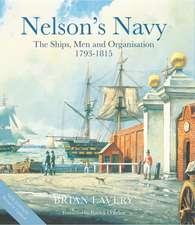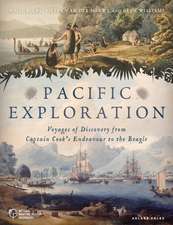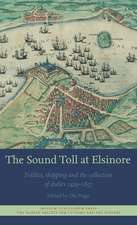Empires of the Sea
Autor Roger Crowleyen Limba Engleză Paperback – 4 iul 2013
Opening with the Ottoman victory in 1453 it is a breathtaking story of military crusading, Barbary pirates, white slavery and the Ottoman Empire - and the larger picture of the struggle between Islam and Christianity.
| Toate formatele și edițiile | Preț | Express |
|---|---|---|
| Paperback (2) | 82.61 lei 3-5 săpt. | +11.94 lei 5-11 zile |
| FABER & FABER – 4 iul 2013 | 82.61 lei 3-5 săpt. | +11.94 lei 5-11 zile |
| Random House Trade – 30 apr 2009 | 102.44 lei 3-5 săpt. |
Preț: 82.61 lei
Nou
Puncte Express: 124
Preț estimativ în valută:
15.81€ • 17.18$ • 13.29£
15.81€ • 17.18$ • 13.29£
Carte disponibilă
Livrare economică 31 martie-14 aprilie
Livrare express 15-21 martie pentru 21.93 lei
Preluare comenzi: 021 569.72.76
Specificații
ISBN-13: 9780571298198
ISBN-10: 0571298192
Pagini: 368
Ilustrații: Illustrations
Dimensiuni: 126 x 198 x 27 mm
Greutate: 0.29 kg
Ediția:Main. Auflage
Editura: FABER & FABER
ISBN-10: 0571298192
Pagini: 368
Ilustrații: Illustrations
Dimensiuni: 126 x 198 x 27 mm
Greutate: 0.29 kg
Ediția:Main. Auflage
Editura: FABER & FABER
Notă biografică
Roger Crowley was born in 1951 and spent part of his childhood in Malta. He read English at Cambridge University and taught English in Istanbul, where he developed a strong interest in the history of Turkey. He has traveled widely throughout the Mediterranean basin over many years and has a wide-ranging knowledge of its history and culture. He lives in Gloucestershire, England. He is also the author of 1453: The Holy War for Constantinople and the Clash of Islam and the West.
From the Hardcover edition.
From the Hardcover edition.
Extras
Chapter One
The Sultan Pays a Visit
1521–1523
10 September 1521, from Belgrade
First the drumroll of imperial titles. Then the threat:
Suleiman the sultan, by the grace of God, king of kings, sovereign of sovereigns, most high emperor of Byzantium and Trebizond, very powerful king of Persia, of Arabia, of Syria, and of Egypt, supreme lord of Europe, and of Asia, prince of Mecca and Aleppo, lord of Jerusalem, and ruler of the universal sea, to Philip de L’Isle Adam, Grand Master of the island of Rhodes, greetings.
I congratulate you upon your new dignity, and upon your arrival within your territories. I trust that you will rule there prosperously, and with even more glory than your predecessors. I also mean to cultivate your favour. Rejoice then with me, as a very dear friend, that following in the footsteps of my father, who conquered Persia, Jerusalem, Arabia and Egypt, I have captured that most powerful of fortresses, Belgrade, during the late Autumn. After which, having offered battle to the Infidel, which they had not the courage to accept, I took many other beautiful and well-fortified cities, and destroyed most of their inhabitants either by sword or fire, the remainder being reduced to slavery. Now after sending my numerous and victorious army into their winter quarters, I shall myself return in triumph to my court at Constantinople.
To those who could read between the lines this was not an expression of friendship. It was a declaration of war. Suleiman, great-grandson of Mehmet the Conqueror, had just inherited the Ottoman throne. According to custom and tradition, he was obliged to mark his accession with victories; each new sultan had to legitimize his position as “Conqueror of the Lands of the Orient and the Occident” by adding fresh territories to the world empire. He could then distribute booty, secure the loyalty of the army, and indulge in the ritual forms of propaganda. Victory letters—assertions of imperial power—were sent out to impress the Muslim world and intimidate the Christian one, and the new sultan could then start building his mosque.
An accession also had to be accompanied by death. The sultan was required by law to kill all his brothers “in the interest of the world order,” to scotch the possibility of civil war. A mournful line of children’s coffins would be carried out of the palace harem to the muted sobbing of women, while stranglers with bowstrings were dispatched to distant provinces to hunt down older siblings.
In Suleiman’s case there were no such deaths. He was the sole male heir. It is likely that his father, Selim, had executed all his other sons six years earlier to snuff out preemptive coups. The twenty-six- year-old was uniquely blessed in his inheritance. He acquired a powerful, unified empire possessed of unrivaled resources. To pious Muslims, Suleiman was the harbinger of good fortune. His name—Solomon— chosen by opening the Koran at random, presaged a ruler dedicated to wisdom and justice. In an age of portents, all the circumstances of Suleiman’s accession were significant. He was the tenth sultan, born in the tenth year of the tenth century of the Muslim era. Ten was the cipher of perfection: the number of the parts of the Koran, the number of disciples of the Prophet, the commandments in the Pentateuch, and the astrological heavens of Islam. And Suleiman stepped onto the world stage at a moment of imperial destiny.
His reign would overlap and compete with the claims of a jostling crowd of rival monarchs: the Hapsburgs, Charles V and Philip II of Spain; the French Valois kings, Francis I and his son Henry II; in England the Tudors, Henry VIII and Elizabeth I; in Muscovy, Ivan the Terrible; in Iran, Shah Ismail; in India, the Mogul emperor Akbar. None would have a keener sense of imperial mission or make for themselves more lofty claims.
From the start Suleiman made a powerful and calculated impression on the foreign ambassadors admitted to his court. “The sultan is tall and slender but tough, with a thin and wiry face,” wrote the Venetian Bartolomeo Contarini. “Rumour has it that Suleiman is aptly named . . . is knowledgeable and shows good judgement.” His countenance was sober, his gaze steady, his caftans simple but magnificent. His height and physical presence were enhanced by the size of the enormous spherical turban pulled low over his forehead, and by his pale face. He meant to impress with the splendor of his person and his court. Soon he would lay claim to the title of Caesar and envisage control of the Mediterranean.
He had two immediate victories in mind. Keenly aware of the achievements of his forebears, Suleiman had dreamed, since boyhood, of completing the twin conquests that had eluded his great- grandfather Mehmet. The first was the storming of the fortress of Belgrade, the gateway to Hungary. Within ten months of his accession, the sultan was encamped before the city walls; by August 1521 he was saying prayers in its Christian cathedral. The second conquest was intended to advance his claim to be “Padishah of the White Sea.” It was to be the capture of Rhodes.
the island to which Suleiman now turned his attention was a strange anachronism—a freak Christian survivor from the medieval Crusades located within touching distance of the Islamic world. Rhodes is the most substantial and fertile of a belt of limestone islands—the Dodecanese, the twelve islands—that stretches for a hundred miles along the coast of Asia Minor. Rhodes lies at the southwest end of the group; the northern marker is the whitewashed monastery island of Patmos, one of Orthodox Christianity’s holy sites, where Saint John the Divine received the revelations of the New Testament. These islands are so closely intertwined with the bays and headlands of the Asian shore that the mainland is always a presence on the horizon. From Rhodes the crossing is a bare eleven miles, just a couple of hours’ sailing time with a smart wind, so near that on clear winter days the snowy Asian mountains, refracted through the thin air, seem almost within touching distance.
When Mehmet took Constantinople in 1453, Christian powers still held the whole of the Aegean Sea in a defensive ring, like an arch whose strength depended on the interdependence of each stone. By 1521, the entire structure had collapsed; yet against gravity, Rhodes, the keystone, survived as an isolated Christian bastion that menaced the Ottomans’ sea-lanes and cramped their maritime ambitions.
Rhodes and its accompanying islands were held in the name of the pope by the last remnant of the great military orders of the Crusades, the Knights of Saint John—the Hospitallers—whose fortunes closely mirrored the whole crusading enterprise. Originally founded to provide care for sick pilgrims in Jerusalem, they had also become, like the Templars and the Teutonic Knights, a military fighting order. Its members took lifelong vows of poverty, chastity, and obedience to the pope; their cardinal purpose was to wage unceasing war on the infidel. The Order of Saint John had fought in every significant action in the long wars of the Holy Land until they were cut down, almost to a man, with their backs to the sea at Acre in May 1291. In exile they searched for a means to continue this struggle, and their eyes alighted on the Greek Christian island of Rhodes. In 1307 they attacked and captured it. Rhodes became Western Christendom’s deep position against the Islamic world, a launchpad from which a new counteroffensive for Palestine could be prepared at some point in the unspecified future.
In the town of Rhodes the knights created a small feudal bastion, a last outpost of the Latin Crusades, subject only to the pope, paid for from the rents on the Order’s huge land holdings in Europe, and dedicated to holy war. The Holy Religion, as the knights called themselves, understood fortified places; they had generations of experience of frontier defense in Palestine. They had constructed Crac des Chevaliers, the greatest of the Crusader castles, and they now fortified the town with bravado and reinvented themselves as sea raiders, building and equipping a small squadron of heavily armed galleys, with which they plundered the Ottoman coasts and sea-lanes, taking slaves and booty.
For two hundred years, the Hospitallers maintained an uncompromising piratical presence on the edge of the Muslim world, holding
the Dodecanese as a chain of fortified islands to pen in the Turks. The knights even managed to keep a toehold on the mainland itself, at the fortress the Turks called Bodrum—the castle of Saint Peter the Liberator. The fortress served both as an escape route for Christian slaves and as a propaganda tool for raising funds for the Order’s mission throughout Europe. The knights, well aware of the fate that had befallen the Templars, managed their image carefully as the Shield of Christendom.
European opinion of the knights was mixed. For the Papacy, Rhodes carried a huge symbolic weight as the outer line of defense against the infidel, manning a maritime frontier in continual contraction as the Byzantine inheritance crumbled before the Islamic advance and one
by one the bright ring of islands fell to the Ottomans. Pope Pius II lamented that “if all the other Christian princes . . . had shown themselves as tireless in their hostility to the Turks as the single island of Rhodes had done, that impious people would not have grown so strong.” Even after the fall of Constantinople, Rhodes continued to nourish the Holy See’s most cherished project—the possibility of an eventual return to the Holy Land. Others were less charitable: to Christian maritime traders, the Hospitallers were a dangerous anachronism. The Order’s acts of piracy and blockades of Western trade with Muslims threatened to destabilize the delicate peace on which commerce depended. The Venetians thought the knights indistinguishable from corsairs and regarded them as a menace second only to Ottoman imperial ambitions.
The knights’ impact certainly outstripped their resources. There were never more than five hundred on Rhodes, drawn from the aristocracy of Europe, supported more or less willingly by the local Greek population and mercenaries. They comprised a small well-organized military elite with a powerful sense of mission whose nuisance value was out of proportion to their number. Their galleys lurked in the aquamarine lagoons and rocky inlets of the Asian shore, quick to snatch passing traffic—boatloads of pilgrims from Istanbul bound for Mecca; timber for Egypt from the Black Sea; cargoes of spices from Arabia; honey, dried fish, wine, and silk. Their reputation was fearsome among friend and foe alike. To tackle a Hospitaller galley was to take on a scorpion. “These corsairs are noted for their energy and daring,” wrote the Ottoman chroniclers. “They disrupt life, causing all sorts of losses to merchants, and capturing travelers.” To Muslims, they were, and always had been, the archenemy, the “evil sect of Franks, the worst sons of Error, the most corrupted of the Devil’s spawn”; the Muslim general Saladin had slaughtered his Hospitaller captives without compunction during the Crusades. Their allegiance to the pope made them doubly loathsome in Ottoman eyes. Worse still, they ran a market on the island for the sale of Muslim slaves. “How many sons of the Prophet are captured by these children of lies?” mourned the Muslim chroniclers. “How many thousand of the faithful are forced to turn infidel? How many wives and children? Their wickedness knows no end.”
Successive sultans perceived Rhodes as a menace, an affront to sovereignty—and unfinished business. Mehmet had sent a large invasion force to take it and been humiliated. When Selim, Suleiman’s father, captured Egypt in 1517, the position of Rhodes astride the sea route to Istanbul increased the island’s strategic threat. The early decades of the sixteenth century were a time of hunger in the Eastern Mediterranean, and food supplies for the capital were critical. “The said Rhodians are inflicting great losses on the sultan’s subjects,” noted the Venetian diarist Sanudo in 1512, the year the knights captured eighteen grain transports bound for Istanbul and forced up the prices there by 50 percent. Complaints to the sultan grew audible: “They don’t let the ships of merchants or pilgrims bound for Egypt pass without sinking them with their cannon and capturing the Muslims.” To Suleiman this was not just a strategic threat; his position as “head of Muhammad’s community” was at stake. The taking of Muslim slaves on the very doorstep of his realm was intolerable. He now decided to crush “the vipers’ nest of Franks.”
nine days after suleiman had written his victory letter in Belgrade, the man to whom it was addressed set foot in Rhodes. His name was Philippe Villiers de L’Isle Adam, a French aristocrat who had just been elected grand master of the Order of Saint John. He was fifty- seven years old, the descendant of a family with a long history of dying for the Crusades. His ancestor had conducted the order’s last- ditch defense at Acre in 1291. L’Isle Adam must have been under few illusions about the task ahead. The voyage from Marseilles to take up his post had been ominous with portents. Off Nice, one of his vessels caught fire; in the Malta Channel, the Order’s great flagship, the Saint Mary, was blasted by a lightning bolt. Nine men fell dead; a crackle of electricity flashed down the grand master’s sword, reducing it to twisted scrap, but he stepped away from the scorched deck unharmed. When the ships put in at Syracuse to repair the storm damage, they found themselves shadowed by the Turkish corsair Kurtoglu, cruising offshore with a powerful squadron of galleys stripped for war. Under cover of darkness, the knights quietly slipped from the harbor and outran their pursuers on a westerly wind.
When he read Suleiman’s letter, L’Isle Adam framed a terse response, distinctly short of pleasantries and any recognition of the sultan’s grander titles. “Brother Philippe Villiers de L’Isle Adam, Grand Master of Rhodes, to Suleiman, sultan of the Turks,” it began. “I have right well comprehended the meaning of your letter, which has been presented to me by your ambassador.” The grand master went on to recount the attempt by Kurtoglu to capture the ship on which he was traveling, before concluding with an abrupt “Farewell.” At the same time, he dispatched a parallel letter to the king of France: “Sire, since he became Grand Turk, this is the first letter that he has sent to Rhodes, and we do not accept it as a token of friendship, but rather as a veiled threat.”
The Sultan Pays a Visit
1521–1523
10 September 1521, from Belgrade
First the drumroll of imperial titles. Then the threat:
Suleiman the sultan, by the grace of God, king of kings, sovereign of sovereigns, most high emperor of Byzantium and Trebizond, very powerful king of Persia, of Arabia, of Syria, and of Egypt, supreme lord of Europe, and of Asia, prince of Mecca and Aleppo, lord of Jerusalem, and ruler of the universal sea, to Philip de L’Isle Adam, Grand Master of the island of Rhodes, greetings.
I congratulate you upon your new dignity, and upon your arrival within your territories. I trust that you will rule there prosperously, and with even more glory than your predecessors. I also mean to cultivate your favour. Rejoice then with me, as a very dear friend, that following in the footsteps of my father, who conquered Persia, Jerusalem, Arabia and Egypt, I have captured that most powerful of fortresses, Belgrade, during the late Autumn. After which, having offered battle to the Infidel, which they had not the courage to accept, I took many other beautiful and well-fortified cities, and destroyed most of their inhabitants either by sword or fire, the remainder being reduced to slavery. Now after sending my numerous and victorious army into their winter quarters, I shall myself return in triumph to my court at Constantinople.
To those who could read between the lines this was not an expression of friendship. It was a declaration of war. Suleiman, great-grandson of Mehmet the Conqueror, had just inherited the Ottoman throne. According to custom and tradition, he was obliged to mark his accession with victories; each new sultan had to legitimize his position as “Conqueror of the Lands of the Orient and the Occident” by adding fresh territories to the world empire. He could then distribute booty, secure the loyalty of the army, and indulge in the ritual forms of propaganda. Victory letters—assertions of imperial power—were sent out to impress the Muslim world and intimidate the Christian one, and the new sultan could then start building his mosque.
An accession also had to be accompanied by death. The sultan was required by law to kill all his brothers “in the interest of the world order,” to scotch the possibility of civil war. A mournful line of children’s coffins would be carried out of the palace harem to the muted sobbing of women, while stranglers with bowstrings were dispatched to distant provinces to hunt down older siblings.
In Suleiman’s case there were no such deaths. He was the sole male heir. It is likely that his father, Selim, had executed all his other sons six years earlier to snuff out preemptive coups. The twenty-six- year-old was uniquely blessed in his inheritance. He acquired a powerful, unified empire possessed of unrivaled resources. To pious Muslims, Suleiman was the harbinger of good fortune. His name—Solomon— chosen by opening the Koran at random, presaged a ruler dedicated to wisdom and justice. In an age of portents, all the circumstances of Suleiman’s accession were significant. He was the tenth sultan, born in the tenth year of the tenth century of the Muslim era. Ten was the cipher of perfection: the number of the parts of the Koran, the number of disciples of the Prophet, the commandments in the Pentateuch, and the astrological heavens of Islam. And Suleiman stepped onto the world stage at a moment of imperial destiny.
His reign would overlap and compete with the claims of a jostling crowd of rival monarchs: the Hapsburgs, Charles V and Philip II of Spain; the French Valois kings, Francis I and his son Henry II; in England the Tudors, Henry VIII and Elizabeth I; in Muscovy, Ivan the Terrible; in Iran, Shah Ismail; in India, the Mogul emperor Akbar. None would have a keener sense of imperial mission or make for themselves more lofty claims.
From the start Suleiman made a powerful and calculated impression on the foreign ambassadors admitted to his court. “The sultan is tall and slender but tough, with a thin and wiry face,” wrote the Venetian Bartolomeo Contarini. “Rumour has it that Suleiman is aptly named . . . is knowledgeable and shows good judgement.” His countenance was sober, his gaze steady, his caftans simple but magnificent. His height and physical presence were enhanced by the size of the enormous spherical turban pulled low over his forehead, and by his pale face. He meant to impress with the splendor of his person and his court. Soon he would lay claim to the title of Caesar and envisage control of the Mediterranean.
He had two immediate victories in mind. Keenly aware of the achievements of his forebears, Suleiman had dreamed, since boyhood, of completing the twin conquests that had eluded his great- grandfather Mehmet. The first was the storming of the fortress of Belgrade, the gateway to Hungary. Within ten months of his accession, the sultan was encamped before the city walls; by August 1521 he was saying prayers in its Christian cathedral. The second conquest was intended to advance his claim to be “Padishah of the White Sea.” It was to be the capture of Rhodes.
the island to which Suleiman now turned his attention was a strange anachronism—a freak Christian survivor from the medieval Crusades located within touching distance of the Islamic world. Rhodes is the most substantial and fertile of a belt of limestone islands—the Dodecanese, the twelve islands—that stretches for a hundred miles along the coast of Asia Minor. Rhodes lies at the southwest end of the group; the northern marker is the whitewashed monastery island of Patmos, one of Orthodox Christianity’s holy sites, where Saint John the Divine received the revelations of the New Testament. These islands are so closely intertwined with the bays and headlands of the Asian shore that the mainland is always a presence on the horizon. From Rhodes the crossing is a bare eleven miles, just a couple of hours’ sailing time with a smart wind, so near that on clear winter days the snowy Asian mountains, refracted through the thin air, seem almost within touching distance.
When Mehmet took Constantinople in 1453, Christian powers still held the whole of the Aegean Sea in a defensive ring, like an arch whose strength depended on the interdependence of each stone. By 1521, the entire structure had collapsed; yet against gravity, Rhodes, the keystone, survived as an isolated Christian bastion that menaced the Ottomans’ sea-lanes and cramped their maritime ambitions.
Rhodes and its accompanying islands were held in the name of the pope by the last remnant of the great military orders of the Crusades, the Knights of Saint John—the Hospitallers—whose fortunes closely mirrored the whole crusading enterprise. Originally founded to provide care for sick pilgrims in Jerusalem, they had also become, like the Templars and the Teutonic Knights, a military fighting order. Its members took lifelong vows of poverty, chastity, and obedience to the pope; their cardinal purpose was to wage unceasing war on the infidel. The Order of Saint John had fought in every significant action in the long wars of the Holy Land until they were cut down, almost to a man, with their backs to the sea at Acre in May 1291. In exile they searched for a means to continue this struggle, and their eyes alighted on the Greek Christian island of Rhodes. In 1307 they attacked and captured it. Rhodes became Western Christendom’s deep position against the Islamic world, a launchpad from which a new counteroffensive for Palestine could be prepared at some point in the unspecified future.
In the town of Rhodes the knights created a small feudal bastion, a last outpost of the Latin Crusades, subject only to the pope, paid for from the rents on the Order’s huge land holdings in Europe, and dedicated to holy war. The Holy Religion, as the knights called themselves, understood fortified places; they had generations of experience of frontier defense in Palestine. They had constructed Crac des Chevaliers, the greatest of the Crusader castles, and they now fortified the town with bravado and reinvented themselves as sea raiders, building and equipping a small squadron of heavily armed galleys, with which they plundered the Ottoman coasts and sea-lanes, taking slaves and booty.
For two hundred years, the Hospitallers maintained an uncompromising piratical presence on the edge of the Muslim world, holding
the Dodecanese as a chain of fortified islands to pen in the Turks. The knights even managed to keep a toehold on the mainland itself, at the fortress the Turks called Bodrum—the castle of Saint Peter the Liberator. The fortress served both as an escape route for Christian slaves and as a propaganda tool for raising funds for the Order’s mission throughout Europe. The knights, well aware of the fate that had befallen the Templars, managed their image carefully as the Shield of Christendom.
European opinion of the knights was mixed. For the Papacy, Rhodes carried a huge symbolic weight as the outer line of defense against the infidel, manning a maritime frontier in continual contraction as the Byzantine inheritance crumbled before the Islamic advance and one
by one the bright ring of islands fell to the Ottomans. Pope Pius II lamented that “if all the other Christian princes . . . had shown themselves as tireless in their hostility to the Turks as the single island of Rhodes had done, that impious people would not have grown so strong.” Even after the fall of Constantinople, Rhodes continued to nourish the Holy See’s most cherished project—the possibility of an eventual return to the Holy Land. Others were less charitable: to Christian maritime traders, the Hospitallers were a dangerous anachronism. The Order’s acts of piracy and blockades of Western trade with Muslims threatened to destabilize the delicate peace on which commerce depended. The Venetians thought the knights indistinguishable from corsairs and regarded them as a menace second only to Ottoman imperial ambitions.
The knights’ impact certainly outstripped their resources. There were never more than five hundred on Rhodes, drawn from the aristocracy of Europe, supported more or less willingly by the local Greek population and mercenaries. They comprised a small well-organized military elite with a powerful sense of mission whose nuisance value was out of proportion to their number. Their galleys lurked in the aquamarine lagoons and rocky inlets of the Asian shore, quick to snatch passing traffic—boatloads of pilgrims from Istanbul bound for Mecca; timber for Egypt from the Black Sea; cargoes of spices from Arabia; honey, dried fish, wine, and silk. Their reputation was fearsome among friend and foe alike. To tackle a Hospitaller galley was to take on a scorpion. “These corsairs are noted for their energy and daring,” wrote the Ottoman chroniclers. “They disrupt life, causing all sorts of losses to merchants, and capturing travelers.” To Muslims, they were, and always had been, the archenemy, the “evil sect of Franks, the worst sons of Error, the most corrupted of the Devil’s spawn”; the Muslim general Saladin had slaughtered his Hospitaller captives without compunction during the Crusades. Their allegiance to the pope made them doubly loathsome in Ottoman eyes. Worse still, they ran a market on the island for the sale of Muslim slaves. “How many sons of the Prophet are captured by these children of lies?” mourned the Muslim chroniclers. “How many thousand of the faithful are forced to turn infidel? How many wives and children? Their wickedness knows no end.”
Successive sultans perceived Rhodes as a menace, an affront to sovereignty—and unfinished business. Mehmet had sent a large invasion force to take it and been humiliated. When Selim, Suleiman’s father, captured Egypt in 1517, the position of Rhodes astride the sea route to Istanbul increased the island’s strategic threat. The early decades of the sixteenth century were a time of hunger in the Eastern Mediterranean, and food supplies for the capital were critical. “The said Rhodians are inflicting great losses on the sultan’s subjects,” noted the Venetian diarist Sanudo in 1512, the year the knights captured eighteen grain transports bound for Istanbul and forced up the prices there by 50 percent. Complaints to the sultan grew audible: “They don’t let the ships of merchants or pilgrims bound for Egypt pass without sinking them with their cannon and capturing the Muslims.” To Suleiman this was not just a strategic threat; his position as “head of Muhammad’s community” was at stake. The taking of Muslim slaves on the very doorstep of his realm was intolerable. He now decided to crush “the vipers’ nest of Franks.”
nine days after suleiman had written his victory letter in Belgrade, the man to whom it was addressed set foot in Rhodes. His name was Philippe Villiers de L’Isle Adam, a French aristocrat who had just been elected grand master of the Order of Saint John. He was fifty- seven years old, the descendant of a family with a long history of dying for the Crusades. His ancestor had conducted the order’s last- ditch defense at Acre in 1291. L’Isle Adam must have been under few illusions about the task ahead. The voyage from Marseilles to take up his post had been ominous with portents. Off Nice, one of his vessels caught fire; in the Malta Channel, the Order’s great flagship, the Saint Mary, was blasted by a lightning bolt. Nine men fell dead; a crackle of electricity flashed down the grand master’s sword, reducing it to twisted scrap, but he stepped away from the scorched deck unharmed. When the ships put in at Syracuse to repair the storm damage, they found themselves shadowed by the Turkish corsair Kurtoglu, cruising offshore with a powerful squadron of galleys stripped for war. Under cover of darkness, the knights quietly slipped from the harbor and outran their pursuers on a westerly wind.
When he read Suleiman’s letter, L’Isle Adam framed a terse response, distinctly short of pleasantries and any recognition of the sultan’s grander titles. “Brother Philippe Villiers de L’Isle Adam, Grand Master of Rhodes, to Suleiman, sultan of the Turks,” it began. “I have right well comprehended the meaning of your letter, which has been presented to me by your ambassador.” The grand master went on to recount the attempt by Kurtoglu to capture the ship on which he was traveling, before concluding with an abrupt “Farewell.” At the same time, he dispatched a parallel letter to the king of France: “Sire, since he became Grand Turk, this is the first letter that he has sent to Rhodes, and we do not accept it as a token of friendship, but rather as a veiled threat.”
Recenzii
“[Crowley] offers exquisitely delicate insights and undulating descriptive passages. Yet in his descriptions of the battles, his prose is so taut and tense, it is impossible not to be caught up in the harrowing action.”—Christian Science Monitor
“A masterly narrative that captures the religious fervor, brutality and mayhem of this intensive contest.”—Kirkus Reviews, starred review
“Gripping . . . This is a rare combination of a history book that reads with the detail, insight and pace of a novel.”—Tampa Tribune
“Crowley has an astonishing gift for narration; his account is as exciting as any thriller.”—Wall Street Journal
“Crowley’s page-turner history . . . deserves to be this [season’s] most recommended nonfiction book. . . . Rich in character, action, surprise, what transpired in those few desperate weeks is one of history’s best and most thrilling stories.”—Dallas Morning News
“A masterly narrative that captures the religious fervor, brutality and mayhem of this intensive contest.”—Kirkus Reviews, starred review
“Gripping . . . This is a rare combination of a history book that reads with the detail, insight and pace of a novel.”—Tampa Tribune
“Crowley has an astonishing gift for narration; his account is as exciting as any thriller.”—Wall Street Journal
“Crowley’s page-turner history . . . deserves to be this [season’s] most recommended nonfiction book. . . . Rich in character, action, surprise, what transpired in those few desperate weeks is one of history’s best and most thrilling stories.”—Dallas Morning News


